What is Virus and How do Viruses mutate?
Firstly, we have to know what a virus is. A virus is a tiny infectious agent that is several orders of magnitude smaller than bacteria and other microbes. Viruses are not classified as living beings since they are incapable of carrying out metabolic activities or reproducing on their own. Instead, they are obligatory intracellular parasites, which means they must replicate and proliferate within a host cell.
Viruses have the following characteristics:
Genetic Material:
Viruses include genetic material, either DNA or RNA, that contains the instructions for replication. The shape and complexity of this genetic material vary among viruses.
Virus Protein Coat (Capsid):
Viruses are encased in a protective protein coat known as a capsid. Some viruses have a lipid envelope that is generated from the host cell membrane.
Host Dependency:
Viruses cannot replicate independently of their hosts. To reproduce and generate new virus particles, they must infect a host cell and hijack the host’s cellular machinery.
Infection and Replication:
Virus infection normally requires the virus to attach to particular receptors on the surface of host cells. Once inside, the virus replicates its genetic material and assembles new viral particles using the host cell’s resources.
Diversity:
Viruses may infect a broad variety of hosts, including animals, plants, bacteria (bacteriophages), and even other viruses (viroids). There is a huge variety of viruses, with many different species and kinds.
Pathogenicity and Disease:
Some viruses cause a range of illnesses in people, animals, and plants. The flu virus, HIV (Human Immunodeficiency Virus), and the common cold virus are all examples.
Infection and Replication:
Virus infection normally requires the virus to attach to particular receptors on the surface of host cells. Once inside, the virus replicates its genetic material and assembles new viral particles using the host cell’s resources.
Transmission:
Viruses may infect a broad variety of hosts, including animals, plants, bacteria (bacteriophages), and even other viruses (viroids). There is a huge variety of viruses, with many different species and kinds.
Pathogenicity and Disease:
Some viruses cause a range of illnesses in people, animals, and plants. The flu virus, HIV (Human Immunodeficiency Virus), and the common cold virus are all examples.

How Do viruses mutate?
Genetic Variation:
Viruses have a high rate of genetic variation because of the error-prone nature of their reproduction. When a virus replicates within a host cell, the enzymes that duplicate its genetic material (either DNA or RNA) might make errors. These mistakes cause mutations in the viral DNA.
Point Mutations:
Point mutations are alterations in single nucleotides (the building blocks of DNA or RNA). These alterations might include nucleotide base substitutions, insertions, or deletions. Point mutations are prevalent and can alter viral proteins.
Recombination:
When two distinct viral strains infect the same host cell, certain viruses can undergo genetic recombination. Genetic material from the two strains can mingle during recombination, resulting in the formation of new hybrid viruses with distinct genetic traits.
Segmented Genomes:
Some viruses have segmented genomes, which means that the genetic material is separated into discrete bits or segments. This segmentation can lead to reassortment, which occurs when segments from distinct viral strains mingle during replication, resulting in the development of new viral varieties.
RNA Viruses and High Mutation Rates:
Because the enzymes that replicate RNA are less precise, RNA viruses have greater mutation rates than DNA viruses. RNA viruses, such as HIV and influenza, are notorious for their high mutation rates, which can lead to the creation of drug-resistant strains and novel viral varieties.
Selective Pressure:
The environment puts viruses under selective pressure. Mutations that give the virus a survival advantage, such as greater infectivity or resistance to host immune responses, are more likely to be kept and passed on to subsequent viral generations.
Immune Pressure:
The host’s immune system puts pressure on viruses in order for them to avoid discovery and elimination. This may result in the selection of viral variants with alterations that render them unrecognizable to the immune system.
Antiviral Drug Resistance:
When viruses are exposed to antiviral treatments, mutations that impart resistance to such therapies can occur. This is a significant issue in the treatment of viral illnesses such as HIV and hepatitis.
Zoonotic Transmission:
When viruses spread from animals to humans (zoonotic transmission), they may undergo genetic alterations to adapt to the new host environment. These modifications may aid in the generation of novel human viruses.
Overall, How do viruses mutate is a double-edged sword. While it can result in the formation of novel viral varieties and the evolution of viruses through time, it also poses difficulties in developing effective vaccinations and antiviral medicines. Understanding how viruses change is essential for monitoring and treating viral infections, as well as limiting the spread of novel varieties, especially in the context of emerging infectious illnesses.
How Do Viruses mutate

